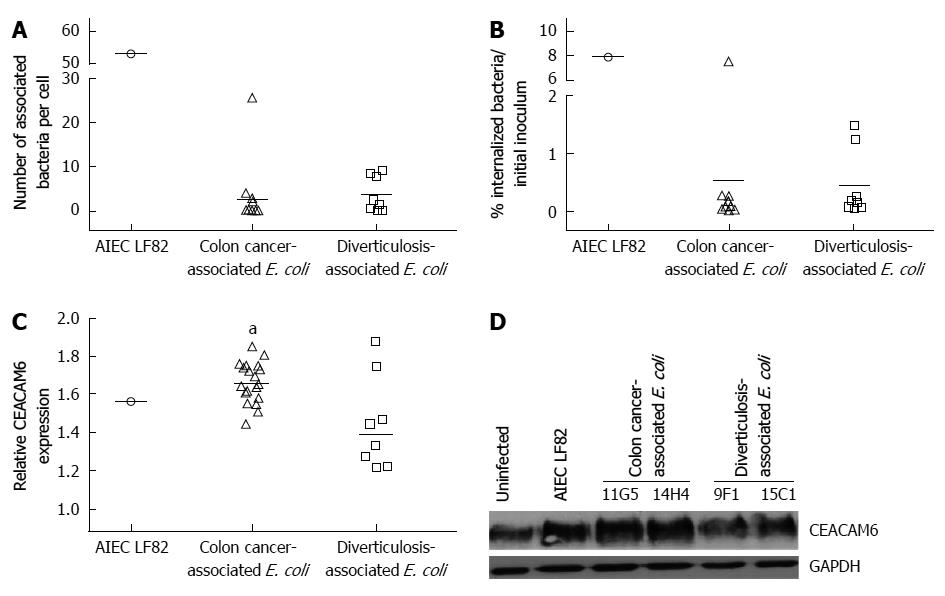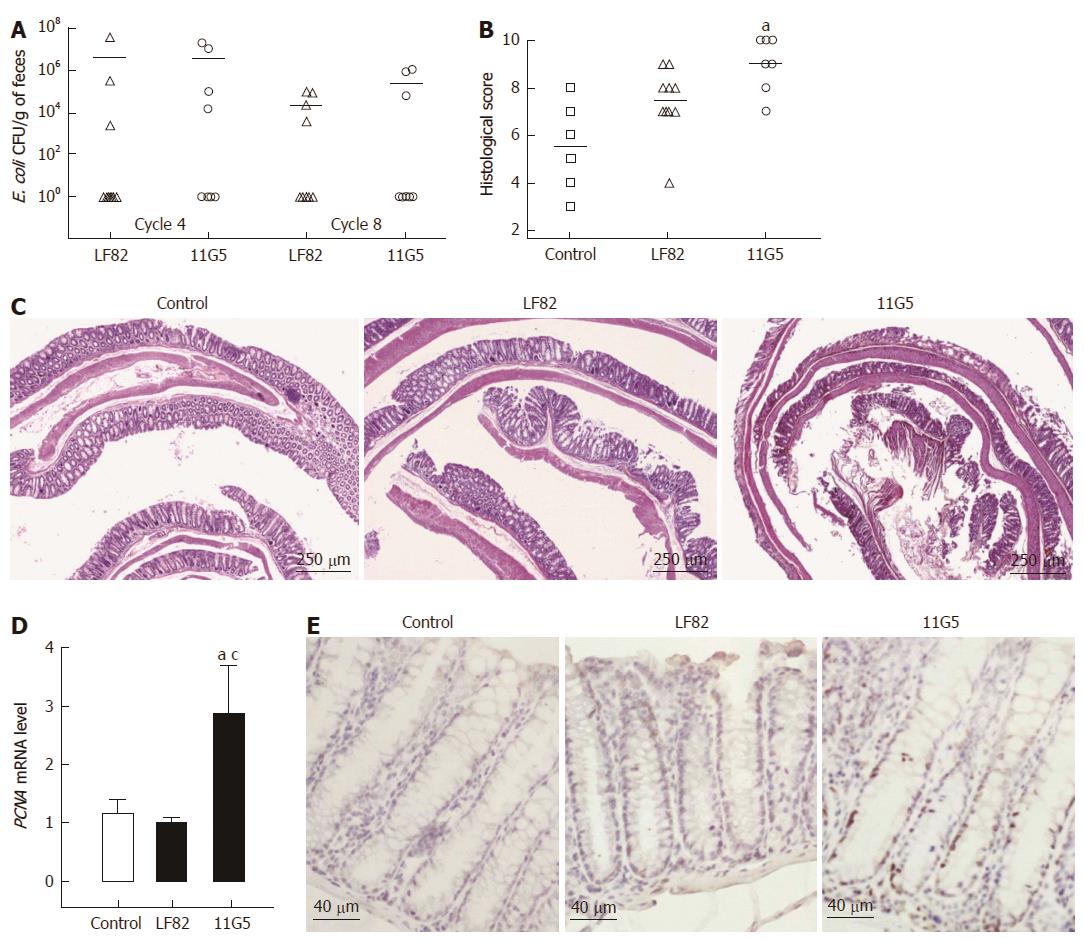Copyright
©2014 Baishideng Publishing Group Inc.
World J Gastroenterol. Jun 7, 2014; 20(21): 6560-6572
Published online Jun 7, 2014. doi: 10.3748/wjg.v20.i21.6560
Published online Jun 7, 2014. doi: 10.3748/wjg.v20.i21.6560
Figure 1 Adhesion, invasion and ability to induce carcinoembryonic antigen-related cell adhesion molecule 6 expression of B2 Escherichia coli strains.
A and B: Ability of colon cancer- and diverticulosis-associated B2 Escherichia coli (E. coli) strains and AIEC strain LF82 to adhere to and to invade I-407 intestinal epithelial cells. A: Adhesion. Results are expressed as number of associated bacteria per cell after 3 h of infection; B: Invasion. Results are expressed as percentage of inoculum surviving after 3 h of infection and 1 h of gentamicin treatment; C and D: Induction of carcinoembryonic antigen-related cell adhesion molecule 6 (CEACAM6) expression in colon epithelial T84 cells infected for 6h with colon cancer- and diverticulosis-associated B2 E. coli strains and AIEC strain LF82. C: Quantitative dosage of CEACAM6 by ELISA. Results are expressed as amounts of CEACAM6 in stimulated or infected cells relative to untreated cells. aP≤ 0.05 vs diverticulosis associated E. coli. D: CEACAM6 expression analysis by Western Blot. E. coli strains 11G5 and 14H4 were isolated from colon cancer patients and E. coli strains 9F1 and 15C1 from patients with diverticulosis.
Figure 2 Ability of B2 Escherichia coli strains to form biofilm.
Biofilm formation of colon cancer-associated and diverticulosis-associated B2 Escherichia coli (E. coli) were compared to that of the non-pathogenic K-12 E. coli strain C600 and the biofilm producer AIEC strain LF82. A: Biofilm formation on abiotic surface. Results are expressed as specific biofilm formation (SBF) index; B: Biofilm formation on human I-407 intestinal epithelial cells. E. coli strain 11G5 was isolated from a patient with colon cancer and E. coli strain 12H1 from a patient with diverticulosis. Bacteria were stained using goat anti-E. coli polyclonal antibodies (green) and I-407 cells were labeled for actin cytoskeleton using TRITC-labeled phalloidin (red). Y- and Z-stack projections are presented.
Figure 3 Impact of CEABAC10 mice colonization by B2 Escherichia coli strain on inflammation and cell proliferation.
CEABAC10 mice transgenic for human CEACAMs, including CEACAM6, were subjected to 8 consecutive cycles of infection with AIEC LF82 or B2 phylogroup Escherichia coli (E. coli) strain 11G5. Control mice received PBS. A: Quantification of the number of bacteria in the feces of mice at cycle 4 and cycle 8; B: Histopathological scoring for several parameters of inflammation and epithelial damages (see Table 2) was performed at the end of the 8th cycle. aP≤ 0.05 vs control; P = NS vs LF82; C: Hematoxylin/eosin/safran (HES) staining of colonic tissue sections; D: Total RNAs from colons were extracted at the end of the 8th cycle. PCNA and S26 mRNA levels were measured by RT-qPCR. PCNA amount relative to S26 is presented. aP≤ 0.05 vs control; cP≤ 0.05 vs LF82; E: Immunohistochemistry examination of Ki67 on colonic tissue sections. NS: Not significant.
-
Citation: Raisch J, Buc E, Bonnet M, Sauvanet P, Vazeille E, de Vallée A, Déchelotte P, Darcha C, Pezet D, Bonnet R, Bringer MA, Darfeuille-Michaud A. Colon cancer-associated B2
Escherichia coli colonize gut mucosa and promote cell proliferation. World J Gastroenterol 2014; 20(21): 6560-6572 - URL: https://www.wjgnet.com/1007-9327/full/v20/i21/6560.htm
- DOI: https://dx.doi.org/10.3748/wjg.v20.i21.6560











